7 Woodpeckers in Missouri (Pictures, ID Guide, and Common Locations)
Seven different species of woodpeckers reside in Missouri. These include the Downy Woodpecker, the Hairy Woodpecker, the Yellow-bellied Sapsucker, the Red-bellied Woodpecker, the Northern Flicker, the Red-headed Woodpecker, and the Pileated Woodpecker. Woodpeckers in Missouri vary in size from roughly the size of a House Finch to about the same size as an American Crow. Two of the species look so much alike even experienced birders can have a hard time differentiating between them. The rest are relatively easy to recognize once you know what to look for. Woodpeckers play a vital role in the ecosystem in Missouri. They eat large numbers of insects and other invertebrates. They also excavate holes that other birds and small mammals can use for nesting. Let’s learn more about the woodpeckers that live in Missouri.
Downy Woodpecker (Dryobates pubescens)
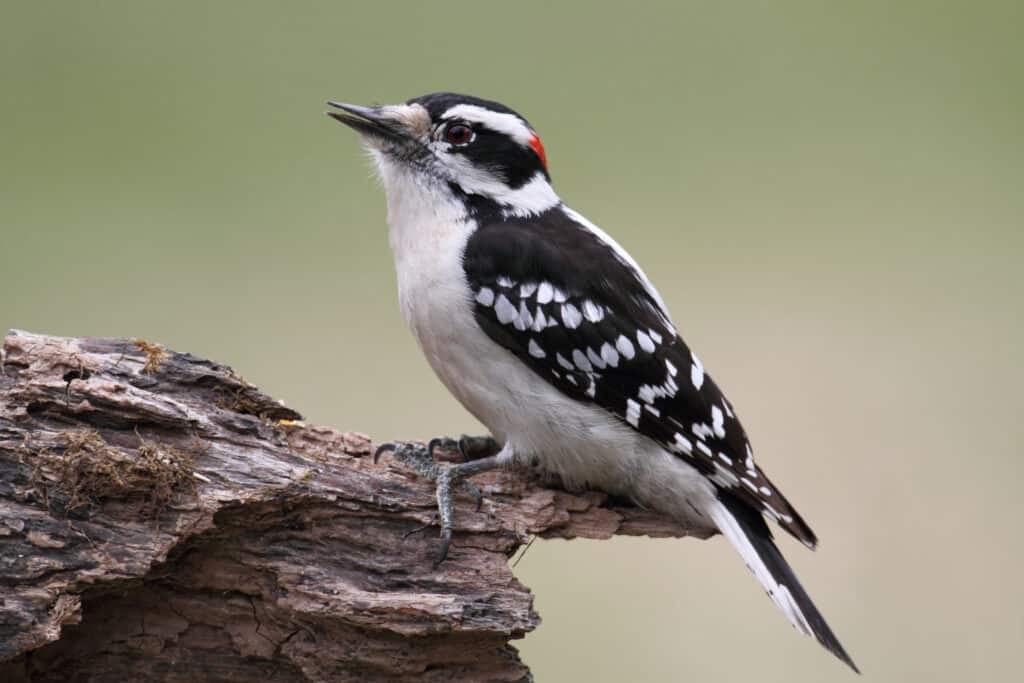
©Steve Byland/Shutterstock.com
The smallest woodpecker in North America, the Downy Woodpecker, is also one of the most widespread woodpeckers in Missouri. It lives in all sorts of open forests all over the state, and it sticks around all throughout the year. This woodpecker also frequents orchards, forest edges, and urban areas like parks and backyards. It often visits feeders, especially if offered suet. Males usually tend to forage high in trees on smaller branches, while females forage lower.
Downy Woodpeckers are roughly the size of songbirds such as large sparrows or finches. They can reach lengths of approximately 6.5 inches and their wingspans reach about 12 inches. The Downy Woodpecker was named for the soft, white, downy feathers on its lower back. These birds have white feathers on both their underparts and their back. Their wings and tail, however, have black feathers with white spots.
The Downy Woodpecker has a prominently striped black and white head, with a black stripe running through their eyeline. It has a short, pointed, black bill with feathers that cover the nostrils. Downy Woodpeckers show sexual dimorphism with a splash of color. Males have a bright red patch near the back of their head, but females have none.
Hairy Woodpecker (Leuconotopicus villosus)
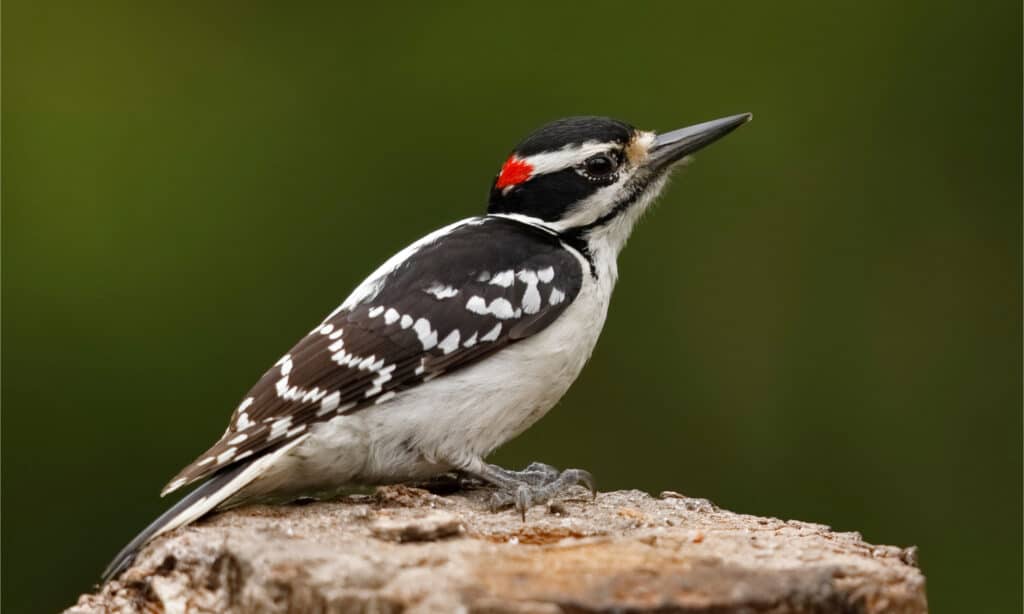
©Brian Lasenby/Shutterstock.com
Hairy Woodpeckers often share territory with Downy Woodpeckers, but they usually prefer larger trees. They also tend to live in older forests. They especially like foraging on trees in areas touched by fire. The extensive range of Hairy Woodpeckers includes most of North America, from Alaska to Central America. These birds make their home in the wooded areas all across the state of Missouri.
The Hairy Woodpecker and the Downy Woodpecker look almost identical, except the Hairy Woodpecker is larger. Even experienced birders can have a hard time distinguishing one from the other. Hairy Woodpeckers grow to be around 9.25 inches, and their wingspans reach approximately 15 inches.
Hairy Woodpeckers have essentially the same colors and markings as Downy Woodpeckers. They have black tails and wings marked with white. They also have white undersides and a white back. The Hairy Woodpecker has a patch of long, hair-like, white feathers on its back, for which it was named. Their black and white striped heads closely resemble those of the Downy Woodpecker, but their bill of the Hairy Woodpecker extends significantly longer. Males of both species sport a red patch on the backs of their heads.
Yellow-bellied Sapsucker (Sphyrapicus varius)
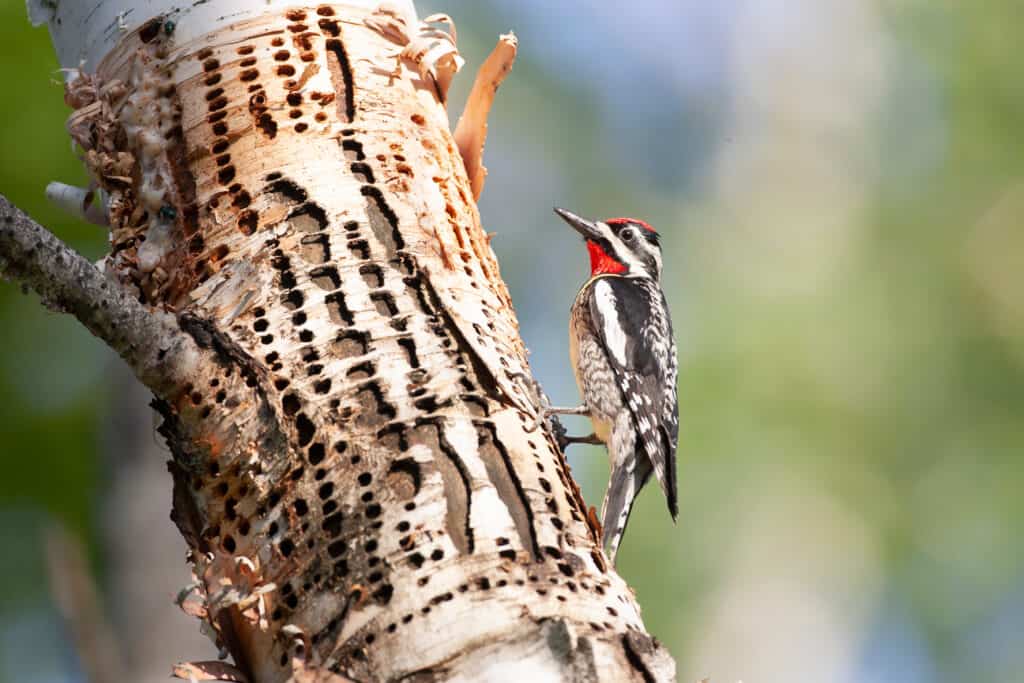
©Dennis W. Donohue /Shutterstock.com
Yellow-bellied Sapsuckers migrate through the state of Missouri in the spring, heading north to their breeding grounds. Some of the birds spend the non-breeding season in the southern two-thirds of the state. They typically stay in open forests where they can forage for food. These woodpeckers drill horizontal rows of holes in young trees to collect sap, a habit that once caused orchard owners to shoot them on sight.
Yellow-bellied Sapsuckers average approximately 8.5 inches in length with a wingspan of about 16 inches. That puts them between the size of the similarly colored Downy Woodpecker and Hairy Woodpecker. As their name would imply, they do have a yellow tinge on their undersides. However, the most distinct feature of the Yellow-bellied Sapsucker is the vertical white stripe on its side. No other woodpecker in Missouri has this characteristic.
The Yellow-bellied Sapsucker has a black patch at the top of its breast. It has a black back, wings, and tail and a white rump. White, splotchy bars mark its back. This woodpecker has a pointy, black bill, a black and white striped face, and a bright red crown. Males have a bright red patch red on their throat, but females have none.
Red-bellied Woodpecker (Melanerpes carolinus)

©Connie Moore/Shutterstock.com
The Red-bellied Woodpecker is a year-round resident in Missouri. It lives in deciduous or mixed forests, and tends to prefer nesting near wetlands or other sources of water. This species makes its nests in dead trees or in large, dead limbs of live trees.
Red-bellied woodpeckers, named for the light red tinge over their breast and belly, have a unique appearance among Missouri woodpeckers. The Red-bellied Woodpecker, when perched on a post or a tree, looks almost as if it is wearing a zebra-striped cloak with a smooth red hood. Its face and underparts are light gray. The black feathers on their back, wings, and tail have white bars. The bright red hoods on males extend from the back of their neck to the base of their bill. Females have red hoods that extend only from the back of their necks to the top of their head.
The Red-bellied Woodpecker, though sleeker in shape, approximately matches the Hairy Woodpecker in size. They average around 9.25 inches in length and have a wingspan of 16 inches. Red-bellied Woodpeckers use their long, heavy, black bill to excavate nests and drum on trees and structures. They also use it to forage for foods, such as insects and other invertebrates, small reptiles, amphibians, and mammals, and fruits and seeds. This behavior differs from most other woodpeckers, which eat mainly insects found on trees.
Northern Flicker (Colaptes auratus)
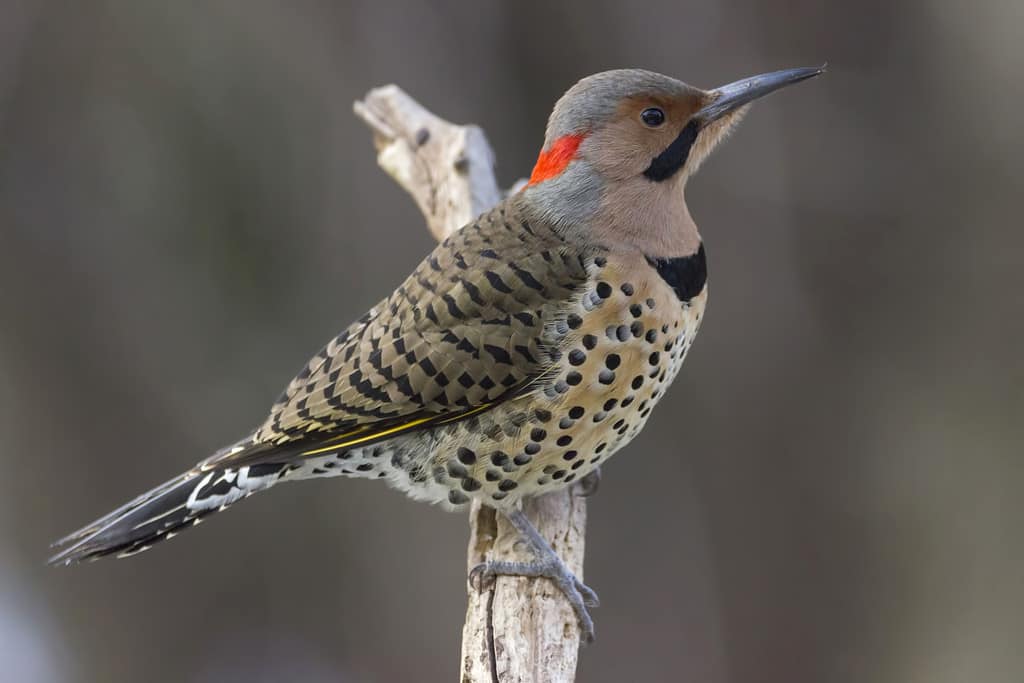
©abriggs21/iStock via Getty Images
Most of the woodpeckers in Missouri have the same basic colors. They have mostly black and white feathers with accents of red. But the Northern Flicker stands apart, not only because it is larger than most, reaching lengths of 12.5 inches with a wingspan of up to 20 inches. It also has a complex color scheme, with a brownish gray body with stenciled black bars across its back. It has a lighter underside accented with black polka dots all over its belly and breast.
The variety of Northern Flicker found in Missouri is common across the eastern United States and was formerly called the Yellow-shafted Flicker. This variety exhibits little sexual dimorphism except for the black mustache found only on males. Both males and females have a light gray hood and a beige face and upper neck. A black crescent that looks like a necklace marks their upper chest. They also have a prominent red patch on the back of their neck. They have yellow on the undersides of both their wings and tail, and they have a white rump.
Northern Flickers range widely, from Alaska and northern Canada to Mexico and the Caribbean. They are permanent residents in Missouri. Northern Flickers live in all types of forests across the state. People can see these unique woodpeckers in open areas along forest edges. Northern Flickers sometimes damage homes and other structures. Some people also consider them pests because males drum incessantly during breeding season on all kinds of natural and artificial surfaces.
Red-headed Woodpecker (Melanerpes erythrocephalus)
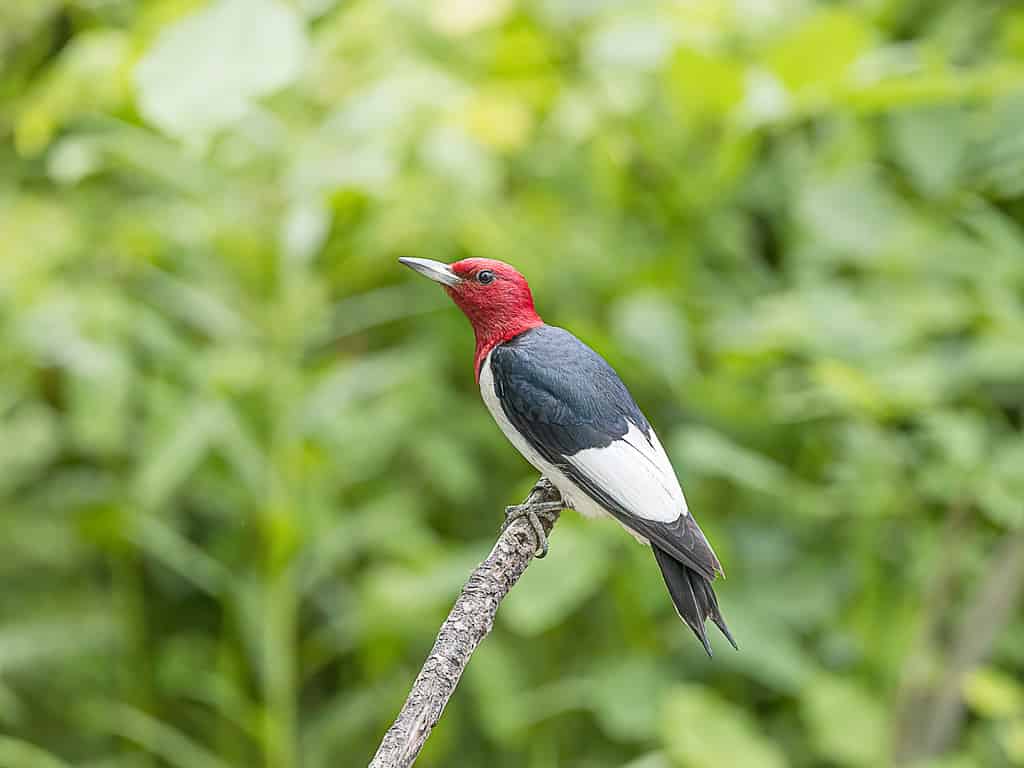
©ilkah/Shutterstock.com
The Red-headed Woodpecker has a declining population and is not seen as often as some other Missouri woodpeckers. It prefers to nest in mature forests with dead or dying trees. These woodpeckers breed in open forests, orchards, or parks near wetlands or other sources of water. They spend their winter in forested lowlands, particularly with oak trees which provide acorns as a food source. The species is a year-round resident in Missouri, but the numbers increase as wintering individuals from the north move into the area.
Red-headed Woodpeckers average about the same size as the Hairy Woodpecker and the Red-bellied Woodpecker. They grow to about 9.25 inches in length and have a wingspan of around 17 inches. But the Red-Headed Woodpecker has a unique appearance among all the woodpeckers in Missouri. Though they have black, white, and red feathers like most of the rest, their pattern sets them apart from every other species in the area.
Red-headed Woodpeckers are named for their completely red heads. Their red hood extends down their neck and ends cleanly like a hood. Their sturdy, light colored bills allow them to easily hammer nuts, berries, and insects into trees and posts. The Red-headed Woodpecker has a white breast and belly, and black back, wings and notched tail. A wide, white splash runs across its back and wings, giving it a striking, tri-tone appearance.
Pileated Woodpecker (Dryocopus pileatus)

©Vlad G/Shutterstock.com
According to the Missouri Department of Conservation, the Pileated Woodpecker lives throughout the state in “appropriate habitats.” An appropriate habitat for this bird would include large, dead trees or mature trees with large, dead limbs. Any part of the state with mature forests and suitable trees for nesting may provide sightings of Pileated Woodpeckers.
This species is the largest woodpecker in Missouri by far. They reach lengths of about 16.5 inches with an impressive wingspan of up to 30 inches. Their body looks entirely black when perched, but in flight, white patches show on top of the wings and underneath. They have a large red crest on their head, a long black bill, and a black and white striped face. A thick, white band runs from the base of their bill all the way down the side of their neck. Males have a red mustache, while females do not.
Catching sight of a Pileated Woodpecker can be very exciting. They were once in steep decline, but their population is increasing in Missouri and across their range. Look high in old trees and you might just spot two or three baby Pileated Woodpeckers sticking their crested heads out of a dead limb, waiting on a meal from one of their parents.
Summary
The following table lists the seven woodpeckers in Missouri, along with key features.
| Common Name | Scientific Name | Size | Special Features |
| Downy Woodpecker | Dryobates pubescens | Length: 6.75″ Wingspan: 12″ | Smallest woodpecker; soft downy feathers on back; small bill |
| Hairy Woodpecker | Leuconotopicus villosus | Length: 9.25″ Wingspan: 15″ | Blocky shape; long, hair-like feathers on back; long bill |
| Yellow-bellied Sapsucker | Sphyrapicus varius | Length: 8.5″ Wingspan: 16″ | Yellow tinge on belly; vertical white bar on side |
| Red-bellied Woodpecker | Melanerpes carolinus | Length: 9.25″ Wingspan: 16″ | Red hood; black and white barred back; red tinge on belly |
| Northern Flicker | Colaptes auratus | Length: 12.5″ Wingspan: 20″ | Brownish gray body; black bars on back and spots on front |
| Red-headed Woodpecker | Melanerpes erythrocephalus | Length: 9.25″ Wingspan: 17″ | Entirely red head; black back with wide, white band |
| Pileated Woodpecker | Dryocopus pileatus | Length: 16.5″ Wingspan: 29″ | Largest woodpecker; big red crest; white markings on wings |









